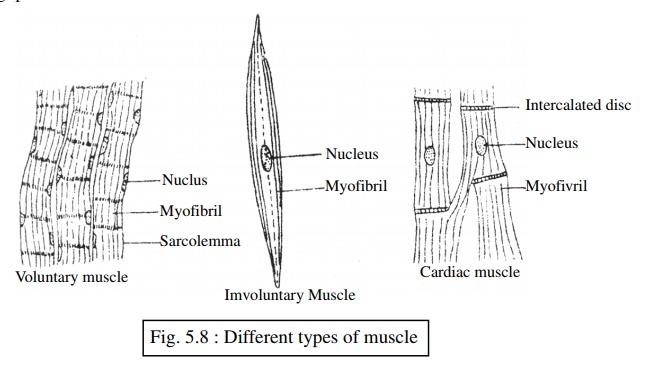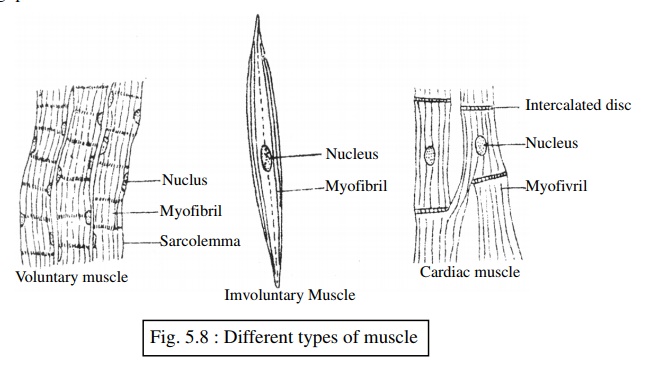Chapter: Biology: Animal Tissue, Organ and Organ System
Structural Characteristics, Function and Location of The Muscular Tissue

The Muscular Tissue:
The particular type of contracting and expanding tissue originates from embryonic, mesoderm is called Muscular tissue (Fig-5.S).
Structural Characteristics: Matrix is nearly absent in muscular tissue. Themuscle cells are elongated and fibre-like. The fibres are spindle shaped. The fibres are known as myofibril. The cytoplasm of muscle cell may have one or more nuclei. The cell membrane of the muscle cell is known as sarcolemma. The myofibrils with transverse striation are known as striated muscle and without striation are known as smooth muscle.

Function: Muscle cells through contraction or expansion take part in organmovement, locomotion and internal circulation. On the basis of location, structure and functions, muscle tissue is of three types. Such as:
Voluntary or Striated Muscle: This Type of muscular tissue can be contracted orexpanded at the will of the living beings. The cells of the voluntary muscle tissue are tubular, not branched and provided with transverse striations. These have generally more than one nucleus. This muscle can contract or expand quickly. This muscle is also, called striated or skeletal muscle.
Location: Voluntary muscles remain attached with the skeletal system as musclesof-hand, and feet of man.
Function: To control the movement and mobilization of different organs byvoluntary movement of various bones.
Involuntary or Smooth Muscle:
Structural Characteristics: The contraction and expansion of this muscle tissue isnot at all of the living beings. This muscle tissue is spindle shaped. Transverse striations are not present here. That is why this muscle is called smooth muscle.
Location: Involuntary muscles are found on the walls of blood vessels, alimentarycanal etc. of the vertebrate animals.
Function: Involuntary muscles mainly take part in the movement of internal organs,e.g. peristalsis. of intestine.
Cardiac Muscle :
Structural Characteristics: The special type of involuntary muscle that formsthe heart of vertebrate animals is called the cardiac muscle. The cells of this mucle tissue are tubular (very similar to those of voluntary muscle), branched and provided with transverse striations. Between the cells of this tissue intercalated disc are present. The contraction and relaxation of this tissue is not dependent on the will of the living beings. That is, the structure of heart muscles is ,like that of voluntary muscle and the function is like that of involuntary muscle. The cells of cardiac muscle, attached by branch joined together by branch. The contraction and expansion of all cardiac muscles take part combindly.
Function: Through rhythmic contraction and relaxation, the cardiac musclescontrol the circulation of blood within the body from a particular stage of the embryonic condition until death.
Related Topics